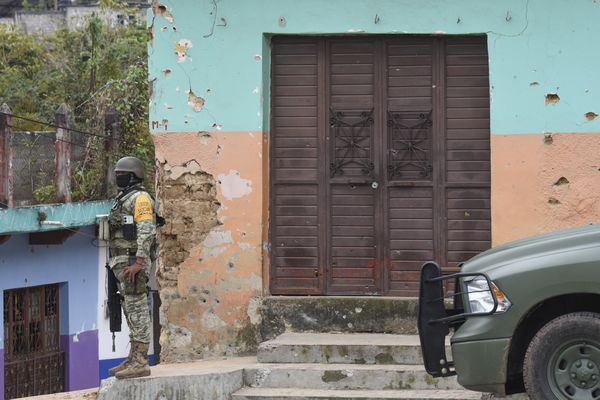
In Gaza, a camera tethered to a drone flies high above, registering a panorama of despair and endless destruction. The images are dusty, harrowing and dead quiet. They’re also stamped with the imprimatur of objective fact, courtesy of satellite imagery captured millions of miles away.
The camera on the ground similarly distils the stakes. From a distance it lingers on Palestinians of all ages, who confront neighbourhoods reduced to killing fields and mass graves. As the camera zooms in, it observes them from painfully intimate angles, snapping images of bewildered and terrified children who run from raining bombs, overwhelmed hospital floors smeared with blood, ambulance convoys, hospitals and refugee camps scorched over and over again by precision bombardments. A whiteboard in Al-Shifa hospital bears a chilling message from medical staff: “We did what we could. Remember us.”
At other times, the camera searches the anguish that not so much cradles as eviscerates those trapped within its grips, commonly missing moments of overt brutality — such as the Israeli army’s execution of an elderly Palestinian crossing the “safe corridor”, or its slaughter of fleeing civilians bearing white flags — as well as a tableaux of quieter moments rendered frequent by the “complete siege” and its onward march of death, disease and starvation.
This is Israel’s war on civilians: both shameless and shameful. A tragedy steeped in terrible grandeur, but one that functions, at its irreducible core, as a horror that mocks international humanitarian law and strikes at our common humanity. The rolling images and footage, as Susan Sontag would say, tell us that this is war — what it does, how it operates: it terrorises and dehumanises. It recasts death as not a stranger but as a permanent shadow, levelling entire cities into hellscapes of grief and distended aloneness.
But war, or rather its carnage, can also elevate human empathy and outrage. Hence the burgeoning mass protests across the globe against the unfolding genocide in Gaza and the US-led impunity that Western countries, including Australia, continue to lend the Israeli government.
Yet experts say that unknown to so many of the some 150,000 who marched in Sydney and Melbourne last week is the reality that Australia’s complicity in Israel’s war crimes runs far deeper, and far wider, than ongoing failures in rhetoric and diplomacy.
There are, for one, credible reasons to suppose intelligence on Gaza gathered at Pine Gap, a satellite surveillance base in the Northern Territory, is being used to support Israel’s military operations. Not only is this entirely likely, former Australian intelligence officer turned academic Clinton Fernandes told Crikey, but it would be occurring with the government’s express approval.
“Despite what Richard Marles is saying, because of Pine Gap we do know what’s going on in Gaza and Israel. And what the government says to that is, ‘Well, we don’t necessarily approve of these activities,’ ” he said, referencing the doctrine of full knowledge and concurrence. “But that simply isn’t backed up by their actions — they do support the eradication of Hamas, which means we’ve gone beyond mere knowledge and concurrence to actual approval.”
Pointing to previous revelations regarding the use of Pine Gap intelligence to assist US drone strikes in the Middle East, Fernandes said such realities raise the ugly spectre of co-belligerency on the part of Australia: “If, comparatively, it was Belarus providing assistance to Russia in its illegal invasion of Ukraine, how many people would take them seriously if they denied they were aiding and abetting Russia’s illegal actions? The answer, of course, is none.”
In recent weeks, the Pentagon has acknowledged it is flying “unarmed” surveillance drones over Gaza to assist Israel. It’s also emerged that the Biden administration has provided US$14 billion worth of aid and arms transfers to Israel since Hamas’ October 7 attack, but in an “unprecedented” move is refusing to disclose the full particulars “due to Israel’s urgent need”, the country’s obvious human rights abuses in the Palestinian territories notwithstanding.
Similar concerns attach to the secrecy enveloping Australian weapons exports to Israel, with Senate estimates last month revealing that more than 350 defence permits, including 52 this year alone, have been granted to the key US strategic ally since 2017. Of equal concern in this regard, is the failure, or refusal, of Defence officials to confirm whether these military permits were approved in accordance with Defence regulations, which among other things require an assessment of the risk the military equipment could be used to commit war crimes.
Seizing on this, Palestinian human rights organisations, supported by the Australian Centre for International Justice (ACIJ), have launched a legal bid in the Federal Court with the aim of ascertaining precisely what’s been sent to Israel and whether the approvals were valid.
“There’s been a real privileging of the defence industry over the Australian people’s right to know,” Rawan Arraf of the ACIJ told Crikey. “And I struggle to think or believe most Australians wouldn’t be appalled at the [potential] use of these exports to commit gross violations of international law against Palestinian people.”
In the view of many experts, the clandestine nature of our weapons exports regime, the operations at Pine Gap and, not least, the dangerous opaqueness surrounding the recent troop deployment to the Middle East, spell a campaign of deliberate misdirection on the part of the federal government, and one designed to infantalise and blind the public.
“We know Israel — like Australia — is a proxy for the US and historically that the US military effort is linked to imperialism and occupation of non-European countries,” University of Technology law Professor Thalia Anthony told Crikey, “and at the moment the focal point obviously is Palestine.”
It’s a sentiment which finds loose reflection in the views of long-time columnist for The New Yorker Susan Glasser, who recently pointed out the Hamas attack wasn’t just an attack on Israel, but rather a “very successful attack on the United States’ interests, not only in the Middle East, but geopolitically”. This, she said, owed not only to the way the unfolding conflict in Gaza had distracted America’s attention and resources from Russia’s war in Ukraine and China’s seeming aggression, but in how it had undermined the credibility of US supremacy and the US-led rules-based order.
Others, however, say the impunity enjoyed by Israel for its atrocities hasn’t undermined the US-led rules-based order so much as exposed it for what it is: little more than a euphemism or vacuous veiled reference to “US empire”.
“The animating force behind our foreign policy isn’t human rights or international law at all — there’s only one standard at play, and it’s to show relevance to and uphold US imperial power,” Fernandes said. “So, the aim of all this secrecy is to shield the government’s alliance with the US from public debate.”
It’s a view shared by Greg Barns SC of the Australian Lawyers Alliance, who told Crikey that “one of the problems in Australia” was that “we allow executive government to run foreign defence policy at expense of the Parliament” — a reality which manifests in the secrecy around defence exports, Pine Gap and the absence of any need for parliamentary approval to entered armed conflict.
In other words, the Albanese government, like those before it, is far more comfortable with charges of hypocrisy — the fiction that inheres in perceptions of double standards on human rights — than it is, and ever would be, with any serious public visibility on the true factors which lend content to our foreign and defence policy.
The fear is that any long gaze in the mirror would reflect back a stranger and unleash all manner of public pressure for reform. And it’s a fear grounded in the reality that anything less would, in the circumstances, be both unworthy of a mature democracy and an assault on our common humanity, as the endless images of untold suffering in Gaza attest.







